Organizational Behaviour Report: Culture, Motivation and Team Dynamics
VerifiedAdded on 2020/07/22
|13
|4168
|336
Report
AI Summary
This report provides an in-depth analysis of organizational behaviour within the context of 4com plc, a telecommunications company. It explores the influence of organizational culture, power, and politics on individual and team performance, highlighting the importance of a positive work environment. The report delves into various motivational theories, including content theories (Maslow's hierarchy of needs and Herzberg's two-factor theory) and process theories (reinforcement, expectancy, equity, and goal-setting), and their application in motivating employees. Furthermore, the report examines the characteristics of effective and ineffective teams, emphasizing the role of organizational behaviour concepts and philosophies in achieving organizational goals. The report also touches upon the significance of intrinsic and extrinsic motivation in the workplace, offering a comprehensive understanding of how to enhance employee performance and contribute to overall company success.
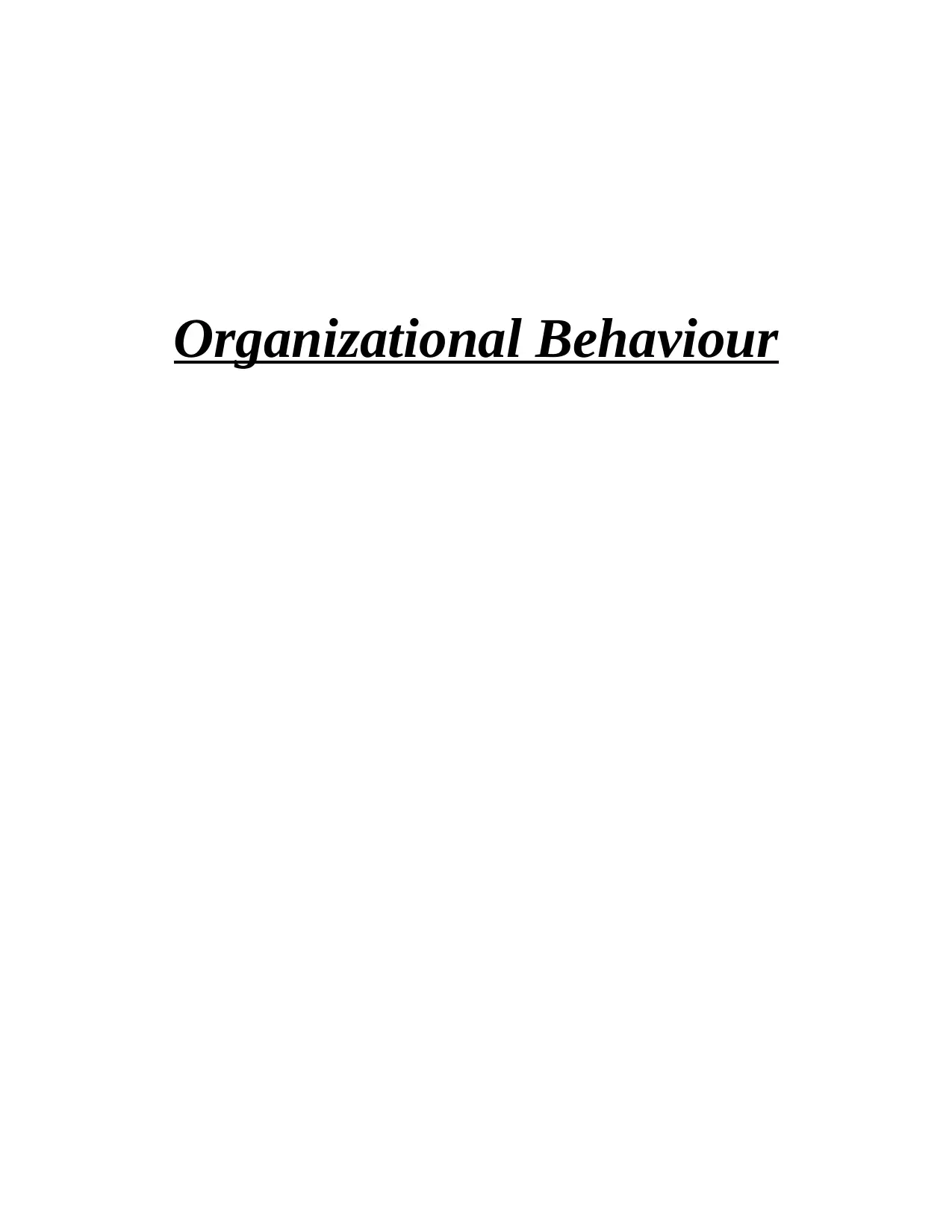
Organizational Behaviour
Paraphrase This Document
Need a fresh take? Get an instant paraphrase of this document with our AI Paraphraser
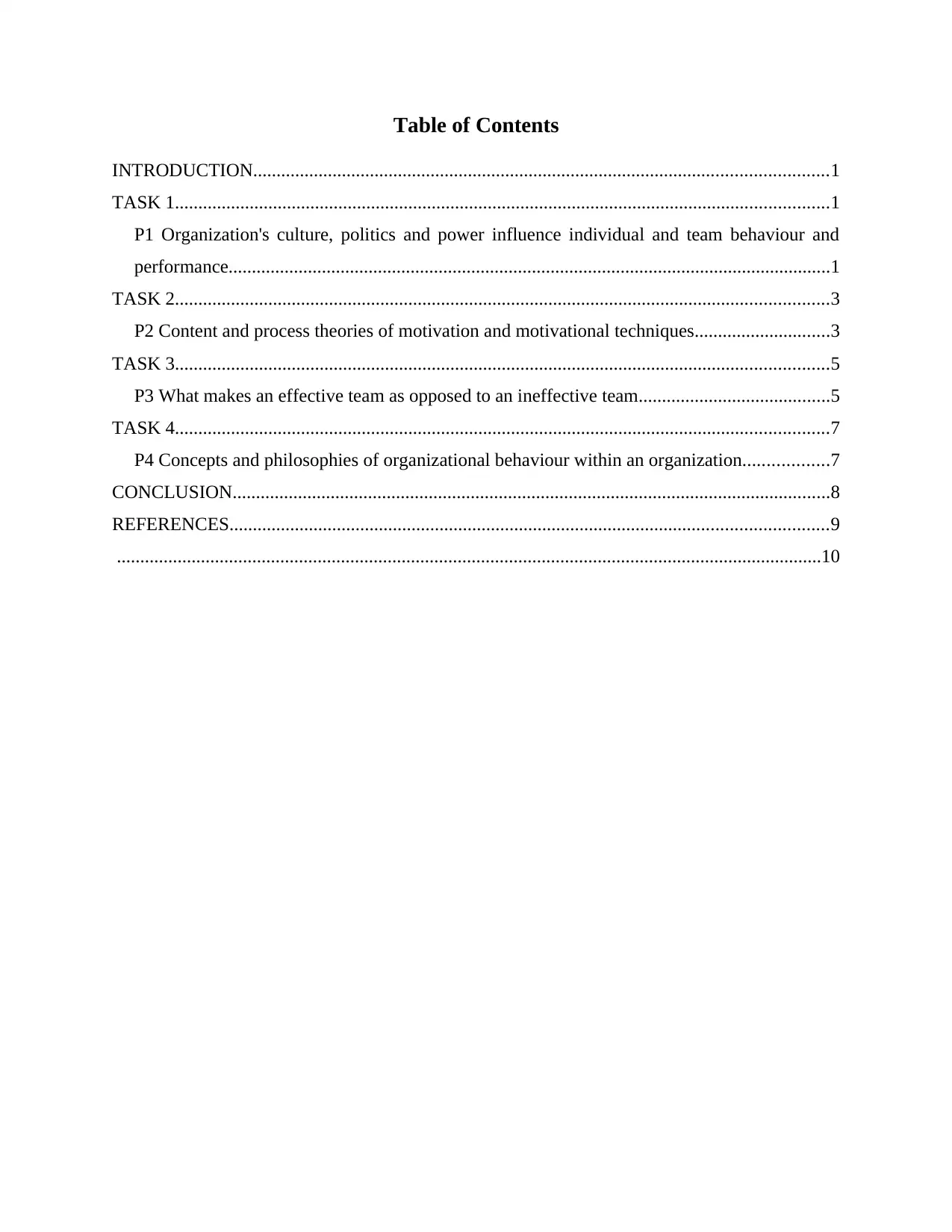
Table of Contents
INTRODUCTION...........................................................................................................................1
TASK 1............................................................................................................................................1
P1 Organization's culture, politics and power influence individual and team behaviour and
performance.................................................................................................................................1
TASK 2............................................................................................................................................3
P2 Content and process theories of motivation and motivational techniques.............................3
TASK 3............................................................................................................................................5
P3 What makes an effective team as opposed to an ineffective team.........................................5
TASK 4............................................................................................................................................7
P4 Concepts and philosophies of organizational behaviour within an organization..................7
CONCLUSION................................................................................................................................8
REFERENCES................................................................................................................................9
.......................................................................................................................................................10
INTRODUCTION...........................................................................................................................1
TASK 1............................................................................................................................................1
P1 Organization's culture, politics and power influence individual and team behaviour and
performance.................................................................................................................................1
TASK 2............................................................................................................................................3
P2 Content and process theories of motivation and motivational techniques.............................3
TASK 3............................................................................................................................................5
P3 What makes an effective team as opposed to an ineffective team.........................................5
TASK 4............................................................................................................................................7
P4 Concepts and philosophies of organizational behaviour within an organization..................7
CONCLUSION................................................................................................................................8
REFERENCES................................................................................................................................9
.......................................................................................................................................................10
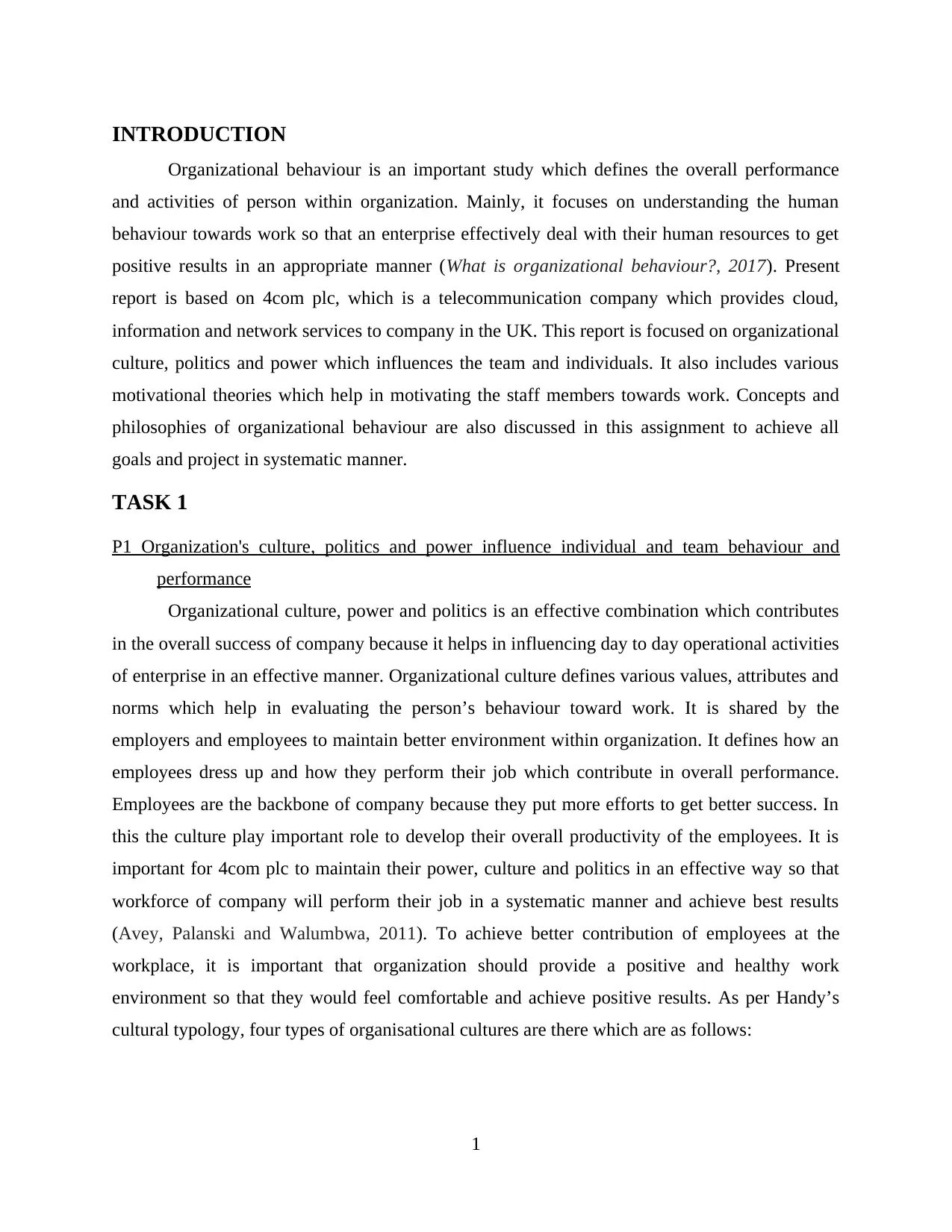
INTRODUCTION
Organizational behaviour is an important study which defines the overall performance
and activities of person within organization. Mainly, it focuses on understanding the human
behaviour towards work so that an enterprise effectively deal with their human resources to get
positive results in an appropriate manner (What is organizational behaviour?, 2017). Present
report is based on 4com plc, which is a telecommunication company which provides cloud,
information and network services to company in the UK. This report is focused on organizational
culture, politics and power which influences the team and individuals. It also includes various
motivational theories which help in motivating the staff members towards work. Concepts and
philosophies of organizational behaviour are also discussed in this assignment to achieve all
goals and project in systematic manner.
TASK 1
P1 Organization's culture, politics and power influence individual and team behaviour and
performance
Organizational culture, power and politics is an effective combination which contributes
in the overall success of company because it helps in influencing day to day operational activities
of enterprise in an effective manner. Organizational culture defines various values, attributes and
norms which help in evaluating the person’s behaviour toward work. It is shared by the
employers and employees to maintain better environment within organization. It defines how an
employees dress up and how they perform their job which contribute in overall performance.
Employees are the backbone of company because they put more efforts to get better success. In
this the culture play important role to develop their overall productivity of the employees. It is
important for 4com plc to maintain their power, culture and politics in an effective way so that
workforce of company will perform their job in a systematic manner and achieve best results
(Avey, Palanski and Walumbwa, 2011). To achieve better contribution of employees at the
workplace, it is important that organization should provide a positive and healthy work
environment so that they would feel comfortable and achieve positive results. As per Handy’s
cultural typology, four types of organisational cultures are there which are as follows:
1
Organizational behaviour is an important study which defines the overall performance
and activities of person within organization. Mainly, it focuses on understanding the human
behaviour towards work so that an enterprise effectively deal with their human resources to get
positive results in an appropriate manner (What is organizational behaviour?, 2017). Present
report is based on 4com plc, which is a telecommunication company which provides cloud,
information and network services to company in the UK. This report is focused on organizational
culture, politics and power which influences the team and individuals. It also includes various
motivational theories which help in motivating the staff members towards work. Concepts and
philosophies of organizational behaviour are also discussed in this assignment to achieve all
goals and project in systematic manner.
TASK 1
P1 Organization's culture, politics and power influence individual and team behaviour and
performance
Organizational culture, power and politics is an effective combination which contributes
in the overall success of company because it helps in influencing day to day operational activities
of enterprise in an effective manner. Organizational culture defines various values, attributes and
norms which help in evaluating the person’s behaviour toward work. It is shared by the
employers and employees to maintain better environment within organization. It defines how an
employees dress up and how they perform their job which contribute in overall performance.
Employees are the backbone of company because they put more efforts to get better success. In
this the culture play important role to develop their overall productivity of the employees. It is
important for 4com plc to maintain their power, culture and politics in an effective way so that
workforce of company will perform their job in a systematic manner and achieve best results
(Avey, Palanski and Walumbwa, 2011). To achieve better contribution of employees at the
workplace, it is important that organization should provide a positive and healthy work
environment so that they would feel comfortable and achieve positive results. As per Handy’s
cultural typology, four types of organisational cultures are there which are as follows:
1
⊘ This is a preview!⊘
Do you want full access?
Subscribe today to unlock all pages.

Trusted by 1+ million students worldwide
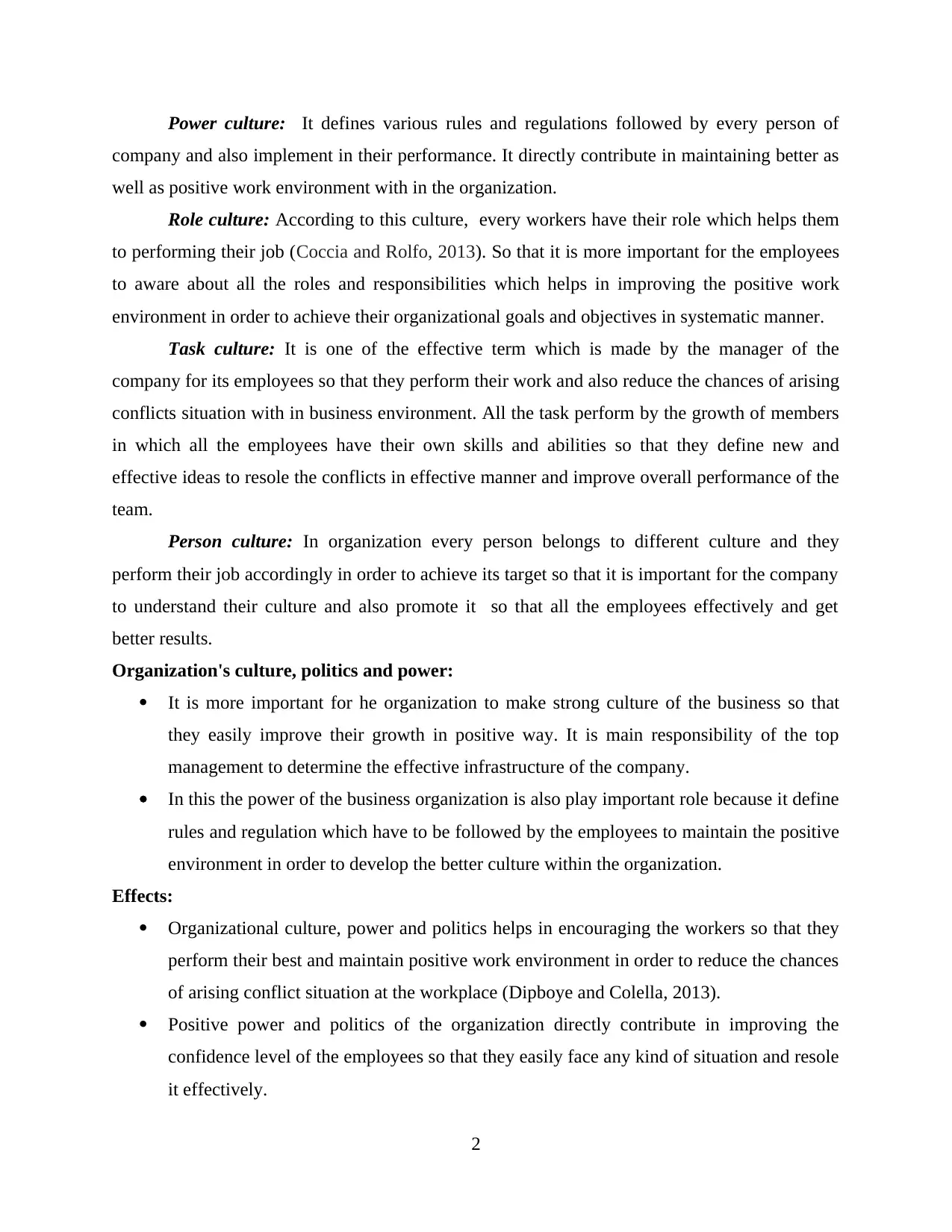
Power culture: It defines various rules and regulations followed by every person of
company and also implement in their performance. It directly contribute in maintaining better as
well as positive work environment with in the organization.
Role culture: According to this culture, every workers have their role which helps them
to performing their job (Coccia and Rolfo, 2013). So that it is more important for the employees
to aware about all the roles and responsibilities which helps in improving the positive work
environment in order to achieve their organizational goals and objectives in systematic manner.
Task culture: It is one of the effective term which is made by the manager of the
company for its employees so that they perform their work and also reduce the chances of arising
conflicts situation with in business environment. All the task perform by the growth of members
in which all the employees have their own skills and abilities so that they define new and
effective ideas to resole the conflicts in effective manner and improve overall performance of the
team.
Person culture: In organization every person belongs to different culture and they
perform their job accordingly in order to achieve its target so that it is important for the company
to understand their culture and also promote it so that all the employees effectively and get
better results.
Organization's culture, politics and power:
It is more important for he organization to make strong culture of the business so that
they easily improve their growth in positive way. It is main responsibility of the top
management to determine the effective infrastructure of the company.
In this the power of the business organization is also play important role because it define
rules and regulation which have to be followed by the employees to maintain the positive
environment in order to develop the better culture within the organization.
Effects:
Organizational culture, power and politics helps in encouraging the workers so that they
perform their best and maintain positive work environment in order to reduce the chances
of arising conflict situation at the workplace (Dipboye and Colella, 2013).
Positive power and politics of the organization directly contribute in improving the
confidence level of the employees so that they easily face any kind of situation and resole
it effectively.
2
company and also implement in their performance. It directly contribute in maintaining better as
well as positive work environment with in the organization.
Role culture: According to this culture, every workers have their role which helps them
to performing their job (Coccia and Rolfo, 2013). So that it is more important for the employees
to aware about all the roles and responsibilities which helps in improving the positive work
environment in order to achieve their organizational goals and objectives in systematic manner.
Task culture: It is one of the effective term which is made by the manager of the
company for its employees so that they perform their work and also reduce the chances of arising
conflicts situation with in business environment. All the task perform by the growth of members
in which all the employees have their own skills and abilities so that they define new and
effective ideas to resole the conflicts in effective manner and improve overall performance of the
team.
Person culture: In organization every person belongs to different culture and they
perform their job accordingly in order to achieve its target so that it is important for the company
to understand their culture and also promote it so that all the employees effectively and get
better results.
Organization's culture, politics and power:
It is more important for he organization to make strong culture of the business so that
they easily improve their growth in positive way. It is main responsibility of the top
management to determine the effective infrastructure of the company.
In this the power of the business organization is also play important role because it define
rules and regulation which have to be followed by the employees to maintain the positive
environment in order to develop the better culture within the organization.
Effects:
Organizational culture, power and politics helps in encouraging the workers so that they
perform their best and maintain positive work environment in order to reduce the chances
of arising conflict situation at the workplace (Dipboye and Colella, 2013).
Positive power and politics of the organization directly contribute in improving the
confidence level of the employees so that they easily face any kind of situation and resole
it effectively.
2
Paraphrase This Document
Need a fresh take? Get an instant paraphrase of this document with our AI Paraphraser
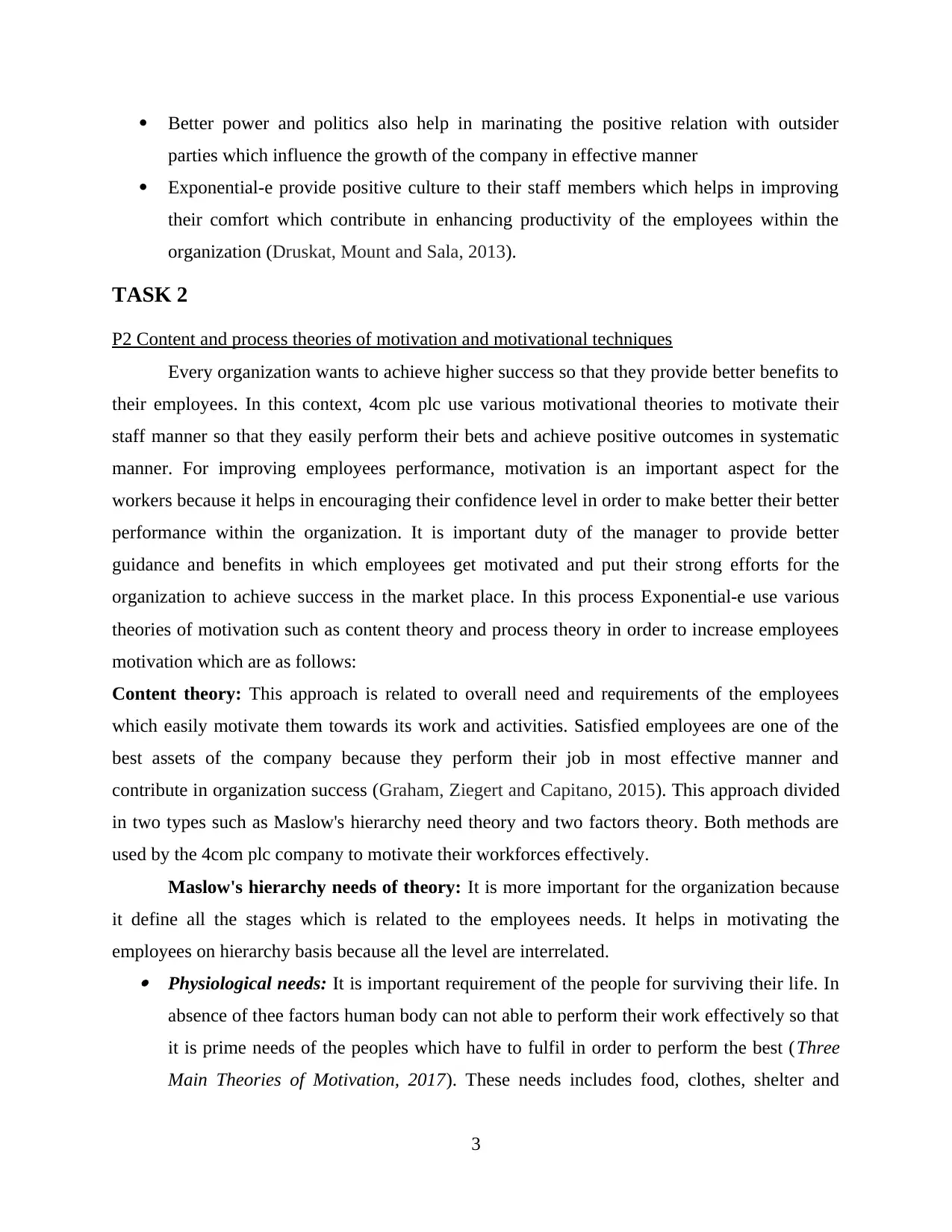
Better power and politics also help in marinating the positive relation with outsider
parties which influence the growth of the company in effective manner
Exponential-e provide positive culture to their staff members which helps in improving
their comfort which contribute in enhancing productivity of the employees within the
organization (Druskat, Mount and Sala, 2013).
TASK 2
P2 Content and process theories of motivation and motivational techniques
Every organization wants to achieve higher success so that they provide better benefits to
their employees. In this context, 4com plc use various motivational theories to motivate their
staff manner so that they easily perform their bets and achieve positive outcomes in systematic
manner. For improving employees performance, motivation is an important aspect for the
workers because it helps in encouraging their confidence level in order to make better their better
performance within the organization. It is important duty of the manager to provide better
guidance and benefits in which employees get motivated and put their strong efforts for the
organization to achieve success in the market place. In this process Exponential-e use various
theories of motivation such as content theory and process theory in order to increase employees
motivation which are as follows:
Content theory: This approach is related to overall need and requirements of the employees
which easily motivate them towards its work and activities. Satisfied employees are one of the
best assets of the company because they perform their job in most effective manner and
contribute in organization success (Graham, Ziegert and Capitano, 2015). This approach divided
in two types such as Maslow's hierarchy need theory and two factors theory. Both methods are
used by the 4com plc company to motivate their workforces effectively.
Maslow's hierarchy needs of theory: It is more important for the organization because
it define all the stages which is related to the employees needs. It helps in motivating the
employees on hierarchy basis because all the level are interrelated. Physiological needs: It is important requirement of the people for surviving their life. In
absence of thee factors human body can not able to perform their work effectively so that
it is prime needs of the peoples which have to fulfil in order to perform the best (Three
Main Theories of Motivation, 2017). These needs includes food, clothes, shelter and
3
parties which influence the growth of the company in effective manner
Exponential-e provide positive culture to their staff members which helps in improving
their comfort which contribute in enhancing productivity of the employees within the
organization (Druskat, Mount and Sala, 2013).
TASK 2
P2 Content and process theories of motivation and motivational techniques
Every organization wants to achieve higher success so that they provide better benefits to
their employees. In this context, 4com plc use various motivational theories to motivate their
staff manner so that they easily perform their bets and achieve positive outcomes in systematic
manner. For improving employees performance, motivation is an important aspect for the
workers because it helps in encouraging their confidence level in order to make better their better
performance within the organization. It is important duty of the manager to provide better
guidance and benefits in which employees get motivated and put their strong efforts for the
organization to achieve success in the market place. In this process Exponential-e use various
theories of motivation such as content theory and process theory in order to increase employees
motivation which are as follows:
Content theory: This approach is related to overall need and requirements of the employees
which easily motivate them towards its work and activities. Satisfied employees are one of the
best assets of the company because they perform their job in most effective manner and
contribute in organization success (Graham, Ziegert and Capitano, 2015). This approach divided
in two types such as Maslow's hierarchy need theory and two factors theory. Both methods are
used by the 4com plc company to motivate their workforces effectively.
Maslow's hierarchy needs of theory: It is more important for the organization because
it define all the stages which is related to the employees needs. It helps in motivating the
employees on hierarchy basis because all the level are interrelated. Physiological needs: It is important requirement of the people for surviving their life. In
absence of thee factors human body can not able to perform their work effectively so that
it is prime needs of the peoples which have to fulfil in order to perform the best (Three
Main Theories of Motivation, 2017). These needs includes food, clothes, shelter and
3
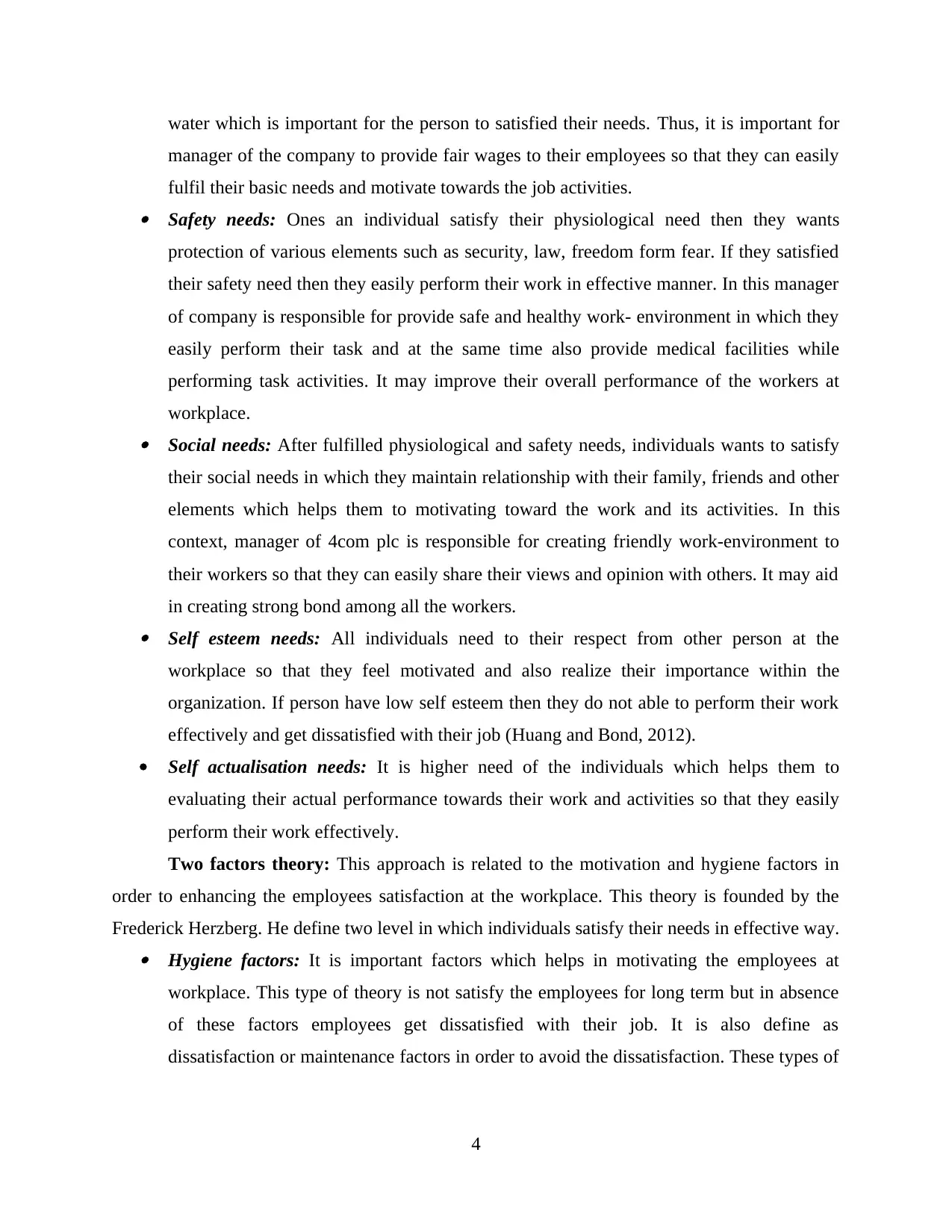
water which is important for the person to satisfied their needs. Thus, it is important for
manager of the company to provide fair wages to their employees so that they can easily
fulfil their basic needs and motivate towards the job activities. Safety needs: Ones an individual satisfy their physiological need then they wants
protection of various elements such as security, law, freedom form fear. If they satisfied
their safety need then they easily perform their work in effective manner. In this manager
of company is responsible for provide safe and healthy work- environment in which they
easily perform their task and at the same time also provide medical facilities while
performing task activities. It may improve their overall performance of the workers at
workplace. Social needs: After fulfilled physiological and safety needs, individuals wants to satisfy
their social needs in which they maintain relationship with their family, friends and other
elements which helps them to motivating toward the work and its activities. In this
context, manager of 4com plc is responsible for creating friendly work-environment to
their workers so that they can easily share their views and opinion with others. It may aid
in creating strong bond among all the workers. Self esteem needs: All individuals need to their respect from other person at the
workplace so that they feel motivated and also realize their importance within the
organization. If person have low self esteem then they do not able to perform their work
effectively and get dissatisfied with their job (Huang and Bond, 2012).
Self actualisation needs: It is higher need of the individuals which helps them to
evaluating their actual performance towards their work and activities so that they easily
perform their work effectively.
Two factors theory: This approach is related to the motivation and hygiene factors in
order to enhancing the employees satisfaction at the workplace. This theory is founded by the
Frederick Herzberg. He define two level in which individuals satisfy their needs in effective way. Hygiene factors: It is important factors which helps in motivating the employees at
workplace. This type of theory is not satisfy the employees for long term but in absence
of these factors employees get dissatisfied with their job. It is also define as
dissatisfaction or maintenance factors in order to avoid the dissatisfaction. These types of
4
manager of the company to provide fair wages to their employees so that they can easily
fulfil their basic needs and motivate towards the job activities. Safety needs: Ones an individual satisfy their physiological need then they wants
protection of various elements such as security, law, freedom form fear. If they satisfied
their safety need then they easily perform their work in effective manner. In this manager
of company is responsible for provide safe and healthy work- environment in which they
easily perform their task and at the same time also provide medical facilities while
performing task activities. It may improve their overall performance of the workers at
workplace. Social needs: After fulfilled physiological and safety needs, individuals wants to satisfy
their social needs in which they maintain relationship with their family, friends and other
elements which helps them to motivating toward the work and its activities. In this
context, manager of 4com plc is responsible for creating friendly work-environment to
their workers so that they can easily share their views and opinion with others. It may aid
in creating strong bond among all the workers. Self esteem needs: All individuals need to their respect from other person at the
workplace so that they feel motivated and also realize their importance within the
organization. If person have low self esteem then they do not able to perform their work
effectively and get dissatisfied with their job (Huang and Bond, 2012).
Self actualisation needs: It is higher need of the individuals which helps them to
evaluating their actual performance towards their work and activities so that they easily
perform their work effectively.
Two factors theory: This approach is related to the motivation and hygiene factors in
order to enhancing the employees satisfaction at the workplace. This theory is founded by the
Frederick Herzberg. He define two level in which individuals satisfy their needs in effective way. Hygiene factors: It is important factors which helps in motivating the employees at
workplace. This type of theory is not satisfy the employees for long term but in absence
of these factors employees get dissatisfied with their job. It is also define as
dissatisfaction or maintenance factors in order to avoid the dissatisfaction. These types of
4
⊘ This is a preview!⊘
Do you want full access?
Subscribe today to unlock all pages.

Trusted by 1+ million students worldwide
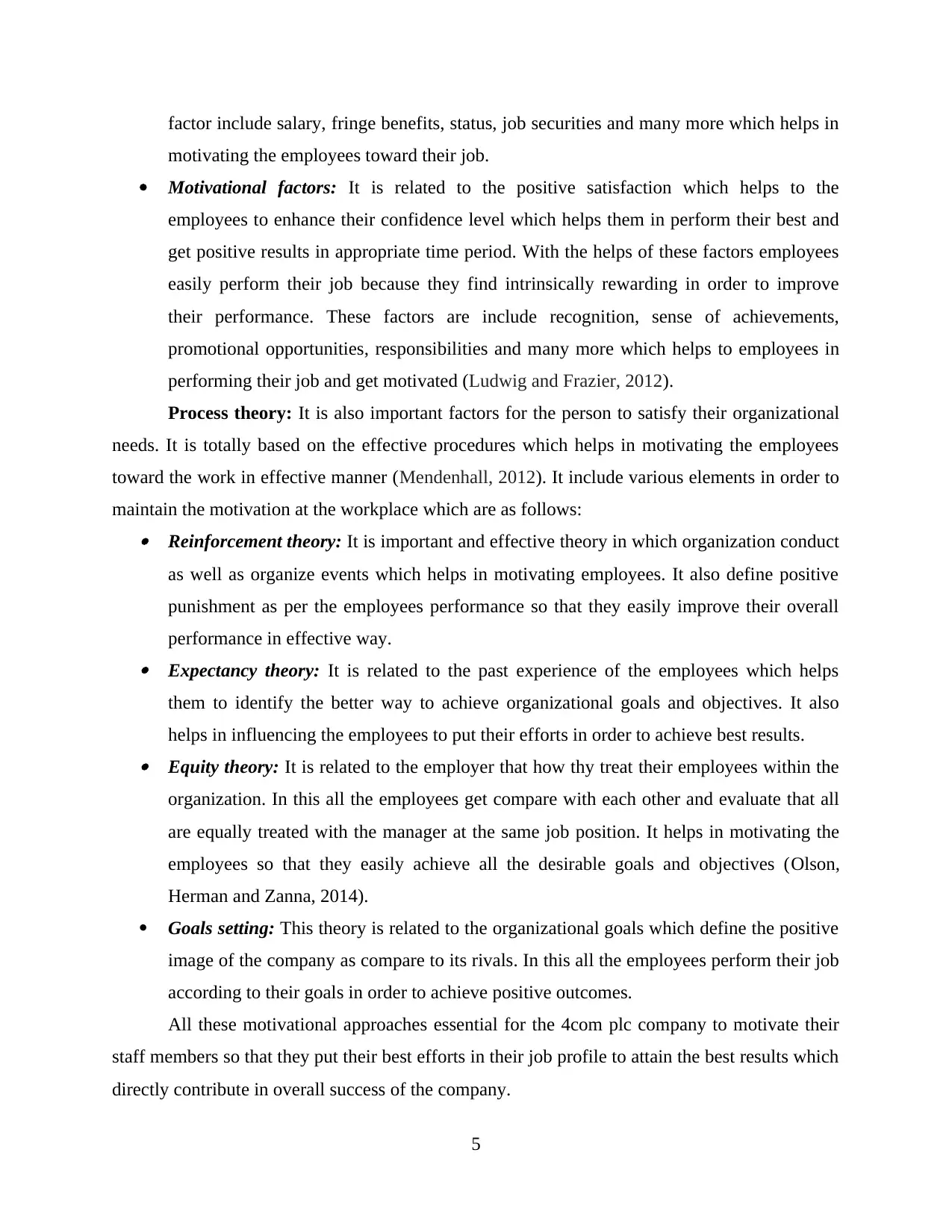
factor include salary, fringe benefits, status, job securities and many more which helps in
motivating the employees toward their job.
Motivational factors: It is related to the positive satisfaction which helps to the
employees to enhance their confidence level which helps them in perform their best and
get positive results in appropriate time period. With the helps of these factors employees
easily perform their job because they find intrinsically rewarding in order to improve
their performance. These factors are include recognition, sense of achievements,
promotional opportunities, responsibilities and many more which helps to employees in
performing their job and get motivated (Ludwig and Frazier, 2012).
Process theory: It is also important factors for the person to satisfy their organizational
needs. It is totally based on the effective procedures which helps in motivating the employees
toward the work in effective manner (Mendenhall, 2012). It include various elements in order to
maintain the motivation at the workplace which are as follows: Reinforcement theory: It is important and effective theory in which organization conduct
as well as organize events which helps in motivating employees. It also define positive
punishment as per the employees performance so that they easily improve their overall
performance in effective way. Expectancy theory: It is related to the past experience of the employees which helps
them to identify the better way to achieve organizational goals and objectives. It also
helps in influencing the employees to put their efforts in order to achieve best results. Equity theory: It is related to the employer that how thy treat their employees within the
organization. In this all the employees get compare with each other and evaluate that all
are equally treated with the manager at the same job position. It helps in motivating the
employees so that they easily achieve all the desirable goals and objectives (Olson,
Herman and Zanna, 2014).
Goals setting: This theory is related to the organizational goals which define the positive
image of the company as compare to its rivals. In this all the employees perform their job
according to their goals in order to achieve positive outcomes.
All these motivational approaches essential for the 4com plc company to motivate their
staff members so that they put their best efforts in their job profile to attain the best results which
directly contribute in overall success of the company.
5
motivating the employees toward their job.
Motivational factors: It is related to the positive satisfaction which helps to the
employees to enhance their confidence level which helps them in perform their best and
get positive results in appropriate time period. With the helps of these factors employees
easily perform their job because they find intrinsically rewarding in order to improve
their performance. These factors are include recognition, sense of achievements,
promotional opportunities, responsibilities and many more which helps to employees in
performing their job and get motivated (Ludwig and Frazier, 2012).
Process theory: It is also important factors for the person to satisfy their organizational
needs. It is totally based on the effective procedures which helps in motivating the employees
toward the work in effective manner (Mendenhall, 2012). It include various elements in order to
maintain the motivation at the workplace which are as follows: Reinforcement theory: It is important and effective theory in which organization conduct
as well as organize events which helps in motivating employees. It also define positive
punishment as per the employees performance so that they easily improve their overall
performance in effective way. Expectancy theory: It is related to the past experience of the employees which helps
them to identify the better way to achieve organizational goals and objectives. It also
helps in influencing the employees to put their efforts in order to achieve best results. Equity theory: It is related to the employer that how thy treat their employees within the
organization. In this all the employees get compare with each other and evaluate that all
are equally treated with the manager at the same job position. It helps in motivating the
employees so that they easily achieve all the desirable goals and objectives (Olson,
Herman and Zanna, 2014).
Goals setting: This theory is related to the organizational goals which define the positive
image of the company as compare to its rivals. In this all the employees perform their job
according to their goals in order to achieve positive outcomes.
All these motivational approaches essential for the 4com plc company to motivate their
staff members so that they put their best efforts in their job profile to attain the best results which
directly contribute in overall success of the company.
5
Paraphrase This Document
Need a fresh take? Get an instant paraphrase of this document with our AI Paraphraser
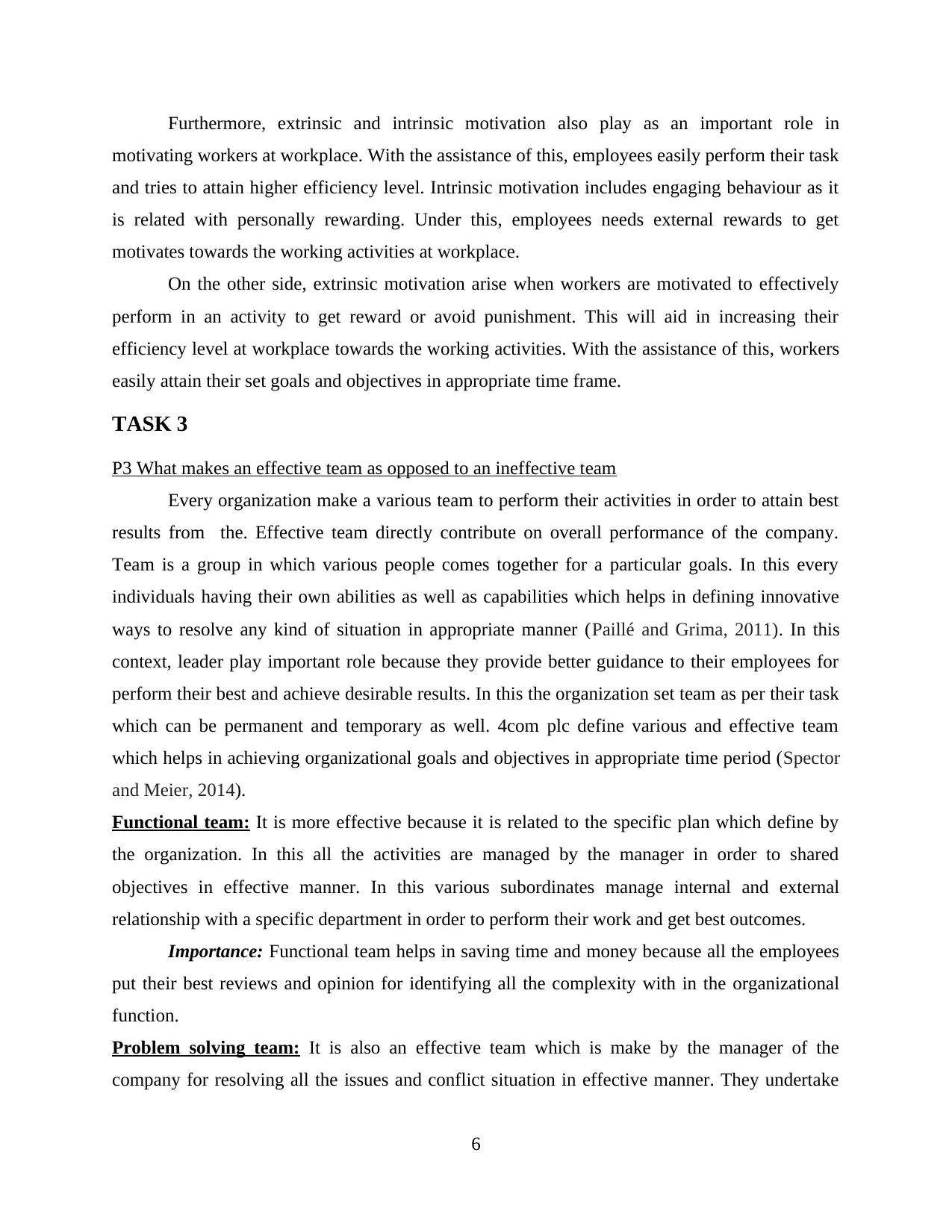
Furthermore, extrinsic and intrinsic motivation also play as an important role in
motivating workers at workplace. With the assistance of this, employees easily perform their task
and tries to attain higher efficiency level. Intrinsic motivation includes engaging behaviour as it
is related with personally rewarding. Under this, employees needs external rewards to get
motivates towards the working activities at workplace.
On the other side, extrinsic motivation arise when workers are motivated to effectively
perform in an activity to get reward or avoid punishment. This will aid in increasing their
efficiency level at workplace towards the working activities. With the assistance of this, workers
easily attain their set goals and objectives in appropriate time frame.
TASK 3
P3 What makes an effective team as opposed to an ineffective team
Every organization make a various team to perform their activities in order to attain best
results from the. Effective team directly contribute on overall performance of the company.
Team is a group in which various people comes together for a particular goals. In this every
individuals having their own abilities as well as capabilities which helps in defining innovative
ways to resolve any kind of situation in appropriate manner (Paillé and Grima, 2011). In this
context, leader play important role because they provide better guidance to their employees for
perform their best and achieve desirable results. In this the organization set team as per their task
which can be permanent and temporary as well. 4com plc define various and effective team
which helps in achieving organizational goals and objectives in appropriate time period (Spector
and Meier, 2014).
Functional team: It is more effective because it is related to the specific plan which define by
the organization. In this all the activities are managed by the manager in order to shared
objectives in effective manner. In this various subordinates manage internal and external
relationship with a specific department in order to perform their work and get best outcomes.
Importance: Functional team helps in saving time and money because all the employees
put their best reviews and opinion for identifying all the complexity with in the organizational
function.
Problem solving team: It is also an effective team which is make by the manager of the
company for resolving all the issues and conflict situation in effective manner. They undertake
6
motivating workers at workplace. With the assistance of this, employees easily perform their task
and tries to attain higher efficiency level. Intrinsic motivation includes engaging behaviour as it
is related with personally rewarding. Under this, employees needs external rewards to get
motivates towards the working activities at workplace.
On the other side, extrinsic motivation arise when workers are motivated to effectively
perform in an activity to get reward or avoid punishment. This will aid in increasing their
efficiency level at workplace towards the working activities. With the assistance of this, workers
easily attain their set goals and objectives in appropriate time frame.
TASK 3
P3 What makes an effective team as opposed to an ineffective team
Every organization make a various team to perform their activities in order to attain best
results from the. Effective team directly contribute on overall performance of the company.
Team is a group in which various people comes together for a particular goals. In this every
individuals having their own abilities as well as capabilities which helps in defining innovative
ways to resolve any kind of situation in appropriate manner (Paillé and Grima, 2011). In this
context, leader play important role because they provide better guidance to their employees for
perform their best and achieve desirable results. In this the organization set team as per their task
which can be permanent and temporary as well. 4com plc define various and effective team
which helps in achieving organizational goals and objectives in appropriate time period (Spector
and Meier, 2014).
Functional team: It is more effective because it is related to the specific plan which define by
the organization. In this all the activities are managed by the manager in order to shared
objectives in effective manner. In this various subordinates manage internal and external
relationship with a specific department in order to perform their work and get best outcomes.
Importance: Functional team helps in saving time and money because all the employees
put their best reviews and opinion for identifying all the complexity with in the organizational
function.
Problem solving team: It is also an effective team which is make by the manager of the
company for resolving all the issues and conflict situation in effective manner. They undertake
6
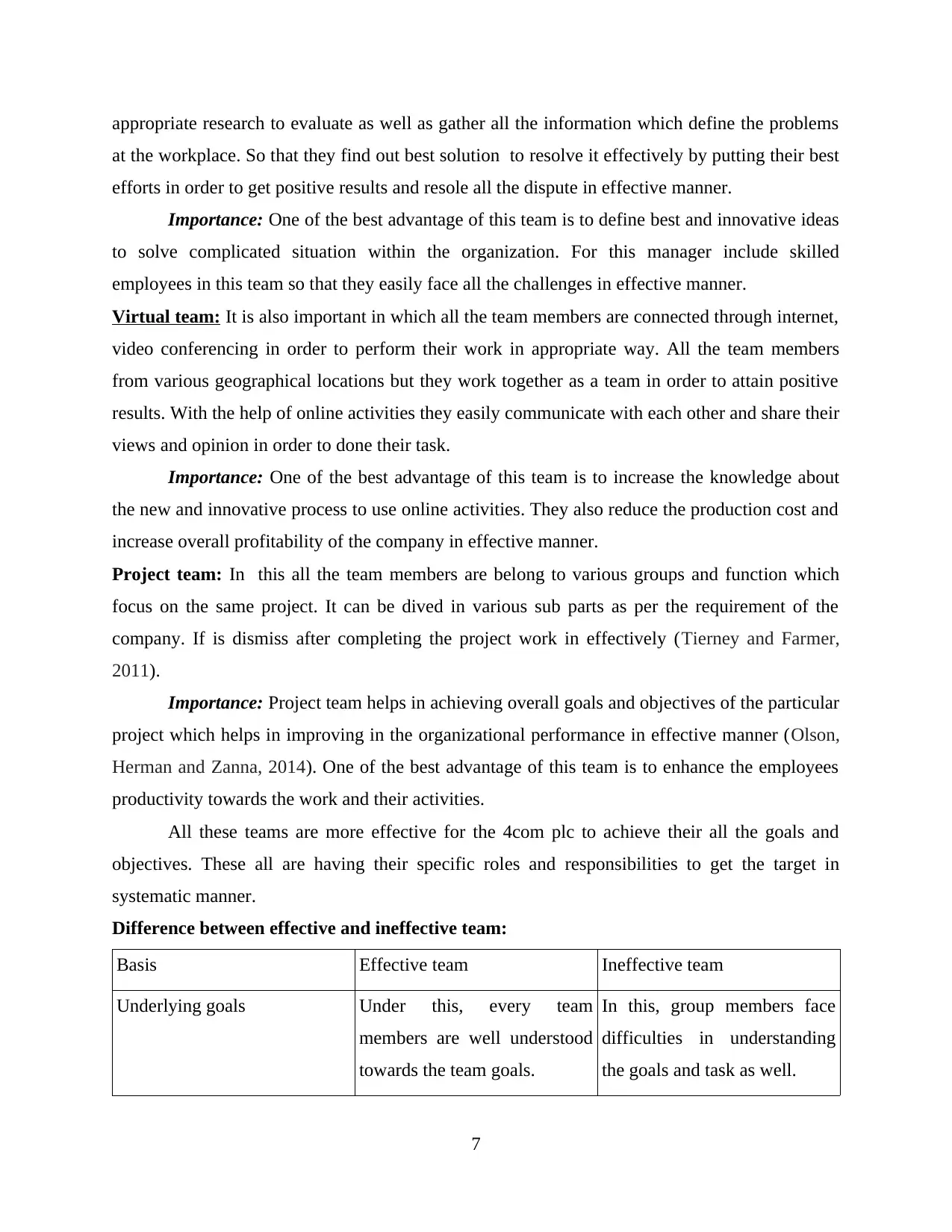
appropriate research to evaluate as well as gather all the information which define the problems
at the workplace. So that they find out best solution to resolve it effectively by putting their best
efforts in order to get positive results and resole all the dispute in effective manner.
Importance: One of the best advantage of this team is to define best and innovative ideas
to solve complicated situation within the organization. For this manager include skilled
employees in this team so that they easily face all the challenges in effective manner.
Virtual team: It is also important in which all the team members are connected through internet,
video conferencing in order to perform their work in appropriate way. All the team members
from various geographical locations but they work together as a team in order to attain positive
results. With the help of online activities they easily communicate with each other and share their
views and opinion in order to done their task.
Importance: One of the best advantage of this team is to increase the knowledge about
the new and innovative process to use online activities. They also reduce the production cost and
increase overall profitability of the company in effective manner.
Project team: In this all the team members are belong to various groups and function which
focus on the same project. It can be dived in various sub parts as per the requirement of the
company. If is dismiss after completing the project work in effectively (Tierney and Farmer,
2011).
Importance: Project team helps in achieving overall goals and objectives of the particular
project which helps in improving in the organizational performance in effective manner (Olson,
Herman and Zanna, 2014). One of the best advantage of this team is to enhance the employees
productivity towards the work and their activities.
All these teams are more effective for the 4com plc to achieve their all the goals and
objectives. These all are having their specific roles and responsibilities to get the target in
systematic manner.
Difference between effective and ineffective team:
Basis Effective team Ineffective team
Underlying goals Under this, every team
members are well understood
towards the team goals.
In this, group members face
difficulties in understanding
the goals and task as well.
7
at the workplace. So that they find out best solution to resolve it effectively by putting their best
efforts in order to get positive results and resole all the dispute in effective manner.
Importance: One of the best advantage of this team is to define best and innovative ideas
to solve complicated situation within the organization. For this manager include skilled
employees in this team so that they easily face all the challenges in effective manner.
Virtual team: It is also important in which all the team members are connected through internet,
video conferencing in order to perform their work in appropriate way. All the team members
from various geographical locations but they work together as a team in order to attain positive
results. With the help of online activities they easily communicate with each other and share their
views and opinion in order to done their task.
Importance: One of the best advantage of this team is to increase the knowledge about
the new and innovative process to use online activities. They also reduce the production cost and
increase overall profitability of the company in effective manner.
Project team: In this all the team members are belong to various groups and function which
focus on the same project. It can be dived in various sub parts as per the requirement of the
company. If is dismiss after completing the project work in effectively (Tierney and Farmer,
2011).
Importance: Project team helps in achieving overall goals and objectives of the particular
project which helps in improving in the organizational performance in effective manner (Olson,
Herman and Zanna, 2014). One of the best advantage of this team is to enhance the employees
productivity towards the work and their activities.
All these teams are more effective for the 4com plc to achieve their all the goals and
objectives. These all are having their specific roles and responsibilities to get the target in
systematic manner.
Difference between effective and ineffective team:
Basis Effective team Ineffective team
Underlying goals Under this, every team
members are well understood
towards the team goals.
In this, group members face
difficulties in understanding
the goals and task as well.
7
⊘ This is a preview!⊘
Do you want full access?
Subscribe today to unlock all pages.

Trusted by 1+ million students worldwide
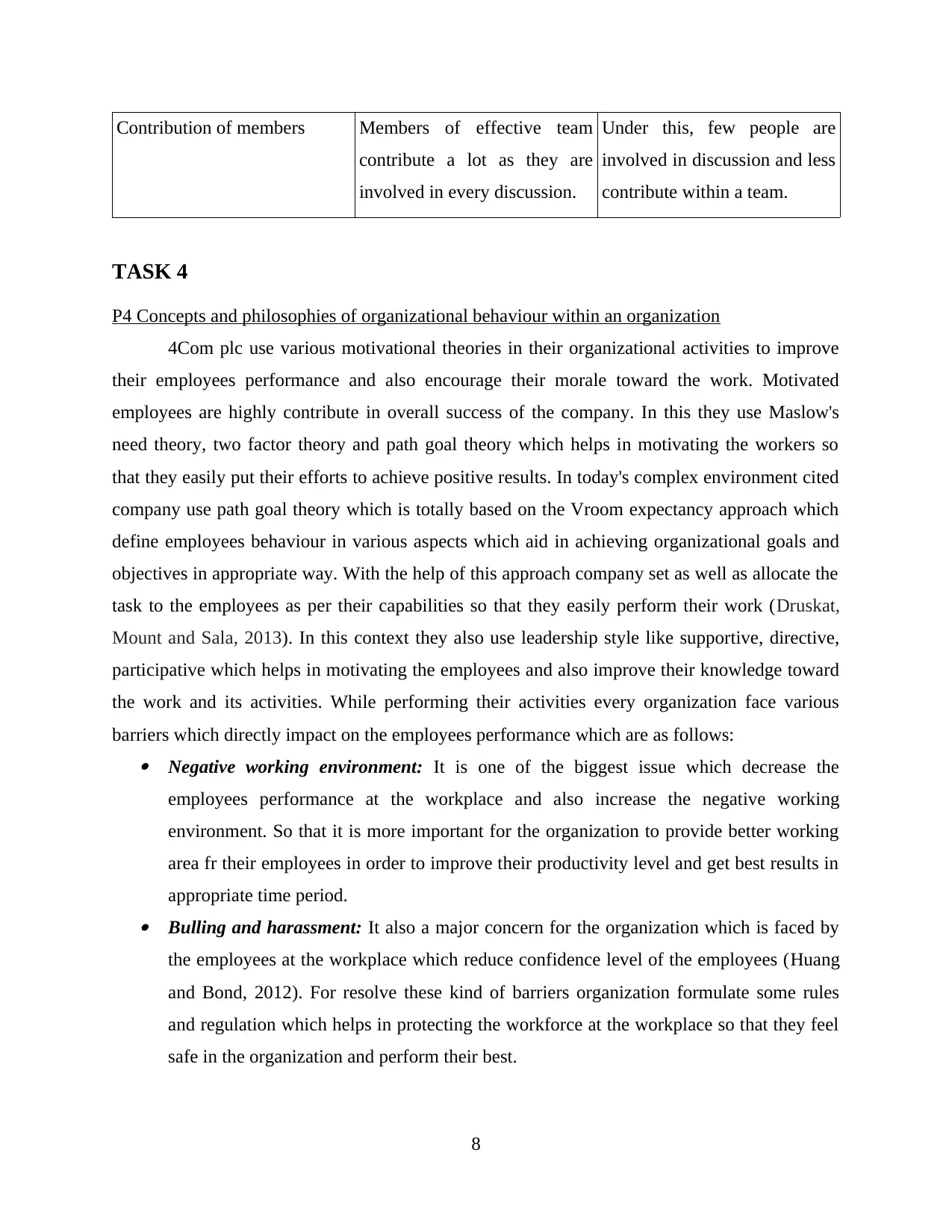
Contribution of members Members of effective team
contribute a lot as they are
involved in every discussion.
Under this, few people are
involved in discussion and less
contribute within a team.
TASK 4
P4 Concepts and philosophies of organizational behaviour within an organization
4Com plc use various motivational theories in their organizational activities to improve
their employees performance and also encourage their morale toward the work. Motivated
employees are highly contribute in overall success of the company. In this they use Maslow's
need theory, two factor theory and path goal theory which helps in motivating the workers so
that they easily put their efforts to achieve positive results. In today's complex environment cited
company use path goal theory which is totally based on the Vroom expectancy approach which
define employees behaviour in various aspects which aid in achieving organizational goals and
objectives in appropriate way. With the help of this approach company set as well as allocate the
task to the employees as per their capabilities so that they easily perform their work (Druskat,
Mount and Sala, 2013). In this context they also use leadership style like supportive, directive,
participative which helps in motivating the employees and also improve their knowledge toward
the work and its activities. While performing their activities every organization face various
barriers which directly impact on the employees performance which are as follows: Negative working environment: It is one of the biggest issue which decrease the
employees performance at the workplace and also increase the negative working
environment. So that it is more important for the organization to provide better working
area fr their employees in order to improve their productivity level and get best results in
appropriate time period. Bulling and harassment: It also a major concern for the organization which is faced by
the employees at the workplace which reduce confidence level of the employees (Huang
and Bond, 2012). For resolve these kind of barriers organization formulate some rules
and regulation which helps in protecting the workforce at the workplace so that they feel
safe in the organization and perform their best.
8
contribute a lot as they are
involved in every discussion.
Under this, few people are
involved in discussion and less
contribute within a team.
TASK 4
P4 Concepts and philosophies of organizational behaviour within an organization
4Com plc use various motivational theories in their organizational activities to improve
their employees performance and also encourage their morale toward the work. Motivated
employees are highly contribute in overall success of the company. In this they use Maslow's
need theory, two factor theory and path goal theory which helps in motivating the workers so
that they easily put their efforts to achieve positive results. In today's complex environment cited
company use path goal theory which is totally based on the Vroom expectancy approach which
define employees behaviour in various aspects which aid in achieving organizational goals and
objectives in appropriate way. With the help of this approach company set as well as allocate the
task to the employees as per their capabilities so that they easily perform their work (Druskat,
Mount and Sala, 2013). In this context they also use leadership style like supportive, directive,
participative which helps in motivating the employees and also improve their knowledge toward
the work and its activities. While performing their activities every organization face various
barriers which directly impact on the employees performance which are as follows: Negative working environment: It is one of the biggest issue which decrease the
employees performance at the workplace and also increase the negative working
environment. So that it is more important for the organization to provide better working
area fr their employees in order to improve their productivity level and get best results in
appropriate time period. Bulling and harassment: It also a major concern for the organization which is faced by
the employees at the workplace which reduce confidence level of the employees (Huang
and Bond, 2012). For resolve these kind of barriers organization formulate some rules
and regulation which helps in protecting the workforce at the workplace so that they feel
safe in the organization and perform their best.
8
Paraphrase This Document
Need a fresh take? Get an instant paraphrase of this document with our AI Paraphraser
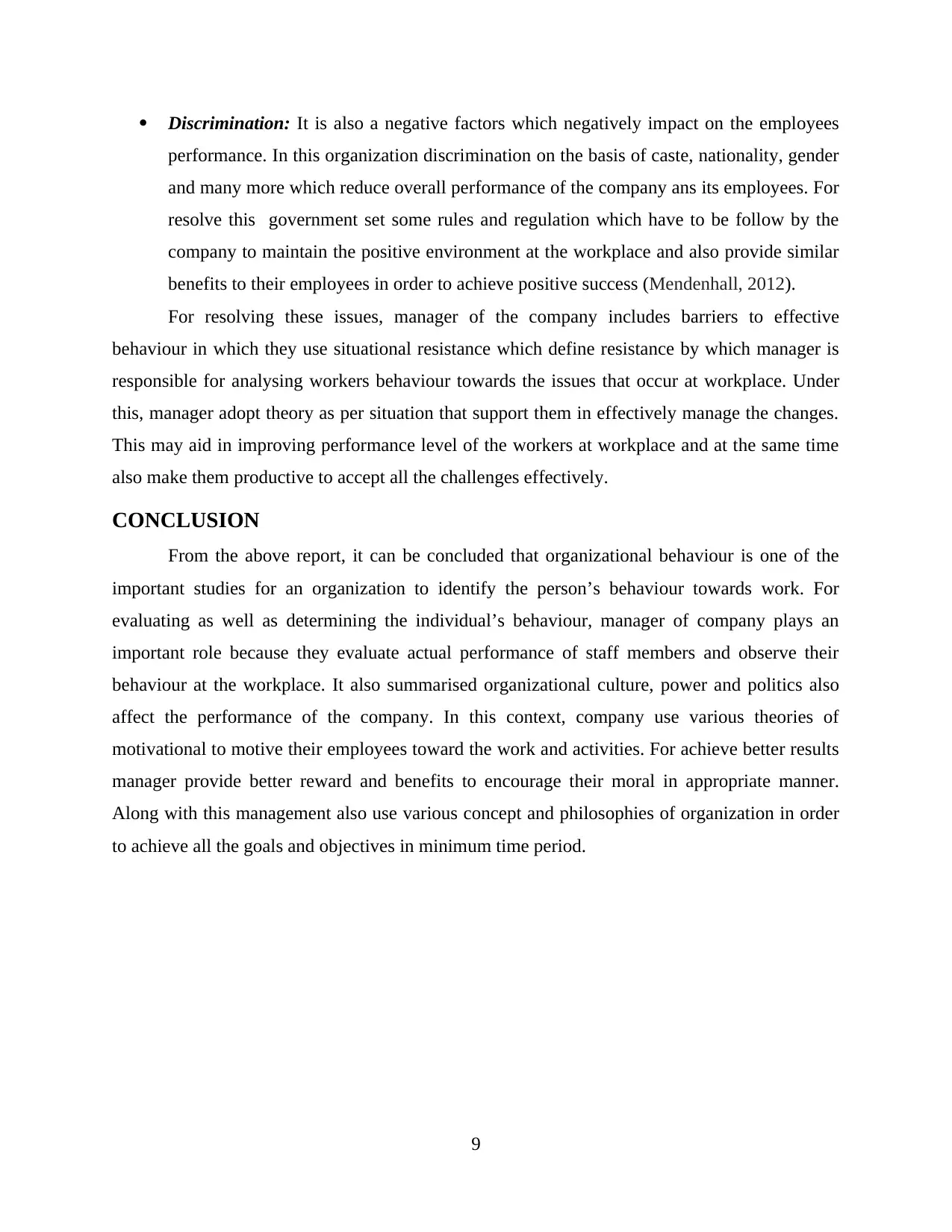
Discrimination: It is also a negative factors which negatively impact on the employees
performance. In this organization discrimination on the basis of caste, nationality, gender
and many more which reduce overall performance of the company ans its employees. For
resolve this government set some rules and regulation which have to be follow by the
company to maintain the positive environment at the workplace and also provide similar
benefits to their employees in order to achieve positive success (Mendenhall, 2012).
For resolving these issues, manager of the company includes barriers to effective
behaviour in which they use situational resistance which define resistance by which manager is
responsible for analysing workers behaviour towards the issues that occur at workplace. Under
this, manager adopt theory as per situation that support them in effectively manage the changes.
This may aid in improving performance level of the workers at workplace and at the same time
also make them productive to accept all the challenges effectively.
CONCLUSION
From the above report, it can be concluded that organizational behaviour is one of the
important studies for an organization to identify the person’s behaviour towards work. For
evaluating as well as determining the individual’s behaviour, manager of company plays an
important role because they evaluate actual performance of staff members and observe their
behaviour at the workplace. It also summarised organizational culture, power and politics also
affect the performance of the company. In this context, company use various theories of
motivational to motive their employees toward the work and activities. For achieve better results
manager provide better reward and benefits to encourage their moral in appropriate manner.
Along with this management also use various concept and philosophies of organization in order
to achieve all the goals and objectives in minimum time period.
9
performance. In this organization discrimination on the basis of caste, nationality, gender
and many more which reduce overall performance of the company ans its employees. For
resolve this government set some rules and regulation which have to be follow by the
company to maintain the positive environment at the workplace and also provide similar
benefits to their employees in order to achieve positive success (Mendenhall, 2012).
For resolving these issues, manager of the company includes barriers to effective
behaviour in which they use situational resistance which define resistance by which manager is
responsible for analysing workers behaviour towards the issues that occur at workplace. Under
this, manager adopt theory as per situation that support them in effectively manage the changes.
This may aid in improving performance level of the workers at workplace and at the same time
also make them productive to accept all the challenges effectively.
CONCLUSION
From the above report, it can be concluded that organizational behaviour is one of the
important studies for an organization to identify the person’s behaviour towards work. For
evaluating as well as determining the individual’s behaviour, manager of company plays an
important role because they evaluate actual performance of staff members and observe their
behaviour at the workplace. It also summarised organizational culture, power and politics also
affect the performance of the company. In this context, company use various theories of
motivational to motive their employees toward the work and activities. For achieve better results
manager provide better reward and benefits to encourage their moral in appropriate manner.
Along with this management also use various concept and philosophies of organization in order
to achieve all the goals and objectives in minimum time period.
9
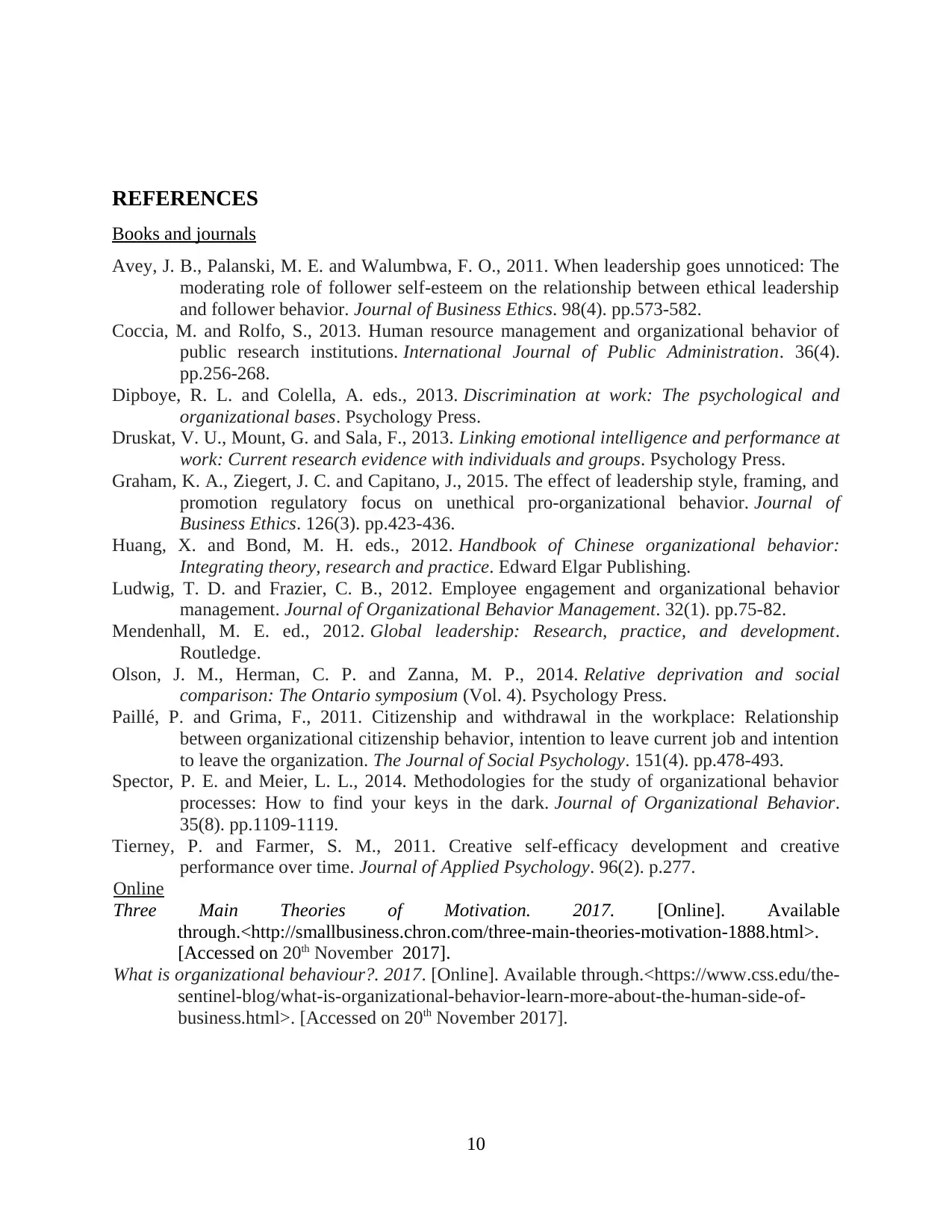
REFERENCES
Books and journals
Avey, J. B., Palanski, M. E. and Walumbwa, F. O., 2011. When leadership goes unnoticed: The
moderating role of follower self-esteem on the relationship between ethical leadership
and follower behavior. Journal of Business Ethics. 98(4). pp.573-582.
Coccia, M. and Rolfo, S., 2013. Human resource management and organizational behavior of
public research institutions. International Journal of Public Administration. 36(4).
pp.256-268.
Dipboye, R. L. and Colella, A. eds., 2013. Discrimination at work: The psychological and
organizational bases. Psychology Press.
Druskat, V. U., Mount, G. and Sala, F., 2013. Linking emotional intelligence and performance at
work: Current research evidence with individuals and groups. Psychology Press.
Graham, K. A., Ziegert, J. C. and Capitano, J., 2015. The effect of leadership style, framing, and
promotion regulatory focus on unethical pro-organizational behavior. Journal of
Business Ethics. 126(3). pp.423-436.
Huang, X. and Bond, M. H. eds., 2012. Handbook of Chinese organizational behavior:
Integrating theory, research and practice. Edward Elgar Publishing.
Ludwig, T. D. and Frazier, C. B., 2012. Employee engagement and organizational behavior
management. Journal of Organizational Behavior Management. 32(1). pp.75-82.
Mendenhall, M. E. ed., 2012. Global leadership: Research, practice, and development.
Routledge.
Olson, J. M., Herman, C. P. and Zanna, M. P., 2014. Relative deprivation and social
comparison: The Ontario symposium (Vol. 4). Psychology Press.
Paillé, P. and Grima, F., 2011. Citizenship and withdrawal in the workplace: Relationship
between organizational citizenship behavior, intention to leave current job and intention
to leave the organization. The Journal of Social Psychology. 151(4). pp.478-493.
Spector, P. E. and Meier, L. L., 2014. Methodologies for the study of organizational behavior
processes: How to find your keys in the dark. Journal of Organizational Behavior.
35(8). pp.1109-1119.
Tierney, P. and Farmer, S. M., 2011. Creative self-efficacy development and creative
performance over time. Journal of Applied Psychology. 96(2). p.277.
Online
Three Main Theories of Motivation. 2017. [Online]. Available
through.<http://smallbusiness.chron.com/three-main-theories-motivation-1888.html>.
[Accessed on 20th November 2017].
What is organizational behaviour?. 2017. [Online]. Available through.<https://www.css.edu/the-
sentinel-blog/what-is-organizational-behavior-learn-more-about-the-human-side-of-
business.html>. [Accessed on 20th November 2017].
10
Books and journals
Avey, J. B., Palanski, M. E. and Walumbwa, F. O., 2011. When leadership goes unnoticed: The
moderating role of follower self-esteem on the relationship between ethical leadership
and follower behavior. Journal of Business Ethics. 98(4). pp.573-582.
Coccia, M. and Rolfo, S., 2013. Human resource management and organizational behavior of
public research institutions. International Journal of Public Administration. 36(4).
pp.256-268.
Dipboye, R. L. and Colella, A. eds., 2013. Discrimination at work: The psychological and
organizational bases. Psychology Press.
Druskat, V. U., Mount, G. and Sala, F., 2013. Linking emotional intelligence and performance at
work: Current research evidence with individuals and groups. Psychology Press.
Graham, K. A., Ziegert, J. C. and Capitano, J., 2015. The effect of leadership style, framing, and
promotion regulatory focus on unethical pro-organizational behavior. Journal of
Business Ethics. 126(3). pp.423-436.
Huang, X. and Bond, M. H. eds., 2012. Handbook of Chinese organizational behavior:
Integrating theory, research and practice. Edward Elgar Publishing.
Ludwig, T. D. and Frazier, C. B., 2012. Employee engagement and organizational behavior
management. Journal of Organizational Behavior Management. 32(1). pp.75-82.
Mendenhall, M. E. ed., 2012. Global leadership: Research, practice, and development.
Routledge.
Olson, J. M., Herman, C. P. and Zanna, M. P., 2014. Relative deprivation and social
comparison: The Ontario symposium (Vol. 4). Psychology Press.
Paillé, P. and Grima, F., 2011. Citizenship and withdrawal in the workplace: Relationship
between organizational citizenship behavior, intention to leave current job and intention
to leave the organization. The Journal of Social Psychology. 151(4). pp.478-493.
Spector, P. E. and Meier, L. L., 2014. Methodologies for the study of organizational behavior
processes: How to find your keys in the dark. Journal of Organizational Behavior.
35(8). pp.1109-1119.
Tierney, P. and Farmer, S. M., 2011. Creative self-efficacy development and creative
performance over time. Journal of Applied Psychology. 96(2). p.277.
Online
Three Main Theories of Motivation. 2017. [Online]. Available
through.<http://smallbusiness.chron.com/three-main-theories-motivation-1888.html>.
[Accessed on 20th November 2017].
What is organizational behaviour?. 2017. [Online]. Available through.<https://www.css.edu/the-
sentinel-blog/what-is-organizational-behavior-learn-more-about-the-human-side-of-
business.html>. [Accessed on 20th November 2017].
10
⊘ This is a preview!⊘
Do you want full access?
Subscribe today to unlock all pages.

Trusted by 1+ million students worldwide
1 out of 13
Related Documents
Your All-in-One AI-Powered Toolkit for Academic Success.
+13062052269
info@desklib.com
Available 24*7 on WhatsApp / Email
![[object Object]](/_next/static/media/star-bottom.7253800d.svg)
Unlock your academic potential
Copyright © 2020–2025 A2Z Services. All Rights Reserved. Developed and managed by ZUCOL.





